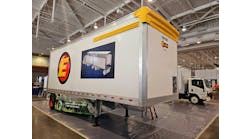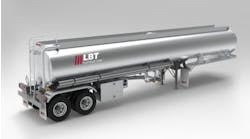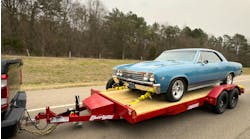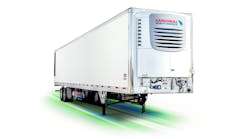RYAN Pinkston listened last summer as a friend extolled the virtues of the Yuppie Wagon. The trailer — with 96.6 cubic feet of storage and a lightweight, roto-molded polyethylene shell — sounded interesting, but he remained unconvinced.
Until he hitched a gray camouflage model to his double-cab pickup and went on a two-week hunting trip that included stops at four ranches between his home in Center, Texas, and San Antonio.
“We could have gotten a heavy cargo trailer, but they don't make any as small as the Yuppie Wagon,” he says. “We could have used a flatbed, but then your equipment is out in the open. We didn't have enough room in the pickup. So the Yuppie Wagon was perfect, particularly since we encountered some rain. You can store all your gear and your guns and your deer, if you're lucky enough to get one. When you pull up to a restaurant or gas station, you don't have to worry about somebody looting you. And it's so light (460 pounds) that you don't even feel it behind you.”
Fred Wulf has heard those words before. Wulf, president/CEO of 5 Star Product Design & Development Group Inc in Center, produced the prototype in June 2002 and says more than 3000 Yuppie Wagons are on the road today.
“You forget it's there,” Wulf says. “That spoiler pushes it down. Even with nothing in it, it just hugs the road.”
The Yuppie Wagon can be easily handled and hitched by one person and can be pulled by any vehicle, including a standard ATV on rough terrain. It has an aerodynamic shape that reduces wind resistance, a rugged steel frame, rot-proof, rust-proof shell, and is available in 15 colors.
A look at the specs:
Single 2000-lb axle; spring suspension, five-bolt/4.5" bolt pattern; Fulton 2" ball coupler; 5/8" treated plywood floor; 7'3" length, 4'1" width for the shell, 10'8" length, 5'9" width, and 5'6.5" height overall for the trailer, and 7'2" length, 3'9.5" width and 4' height for the interior; a single rear door with 36" width and 41" height; GVWR of 1404 lb; and payload capacity of 944 lb.
Diverse market
Wulf is finding a diverse market for the Yuppie Wagon, which received first place from the Association of Rotational Molders International in the large-product category in 2003. He has sold three to a crawfish hauler in southern Louisiana. He has sold 86 to Duke Energy, a Fortune 500 company that supplies, delivers, and processes energy for customers in North America and selected international markets. Duke Energy requested a specialized Yuppie Wagon model with everything coated for environmental purposes, and has ordered 500 more for delivery this year.
“We've sold to Little League teams, Boy Scout troops, Soap Box Derby participants, or just people who have a small car and want a lightweight trailer they can pull on vacations,” Wulf says.
Wulf, a finalist for the 1996 Ernst and Young LLP National Entrepreneur of the Year award, owns the patents, molds, and trademarks for the Yuppie Wagon shell. He says that although some companies produce a fiberglass trailer, he believes his trailer may be the only true plastic model. He developed the idea in 2003 after selling his half-interest in General Shelters' Building Division to founder/chairman James Campbell and his half-interest in the Cooling Division to vice-chairman Rick Campbell.
Wulf had been president/CEO of General Shelters, which is based in Center and produces portable, mobile, and modular buildings, Port-O-Covers, and Perm-A-Covers in its Building Division, and Port-A-Cool portable evaporative cooling units and accessories in its Cooling Division. (If you're an NFL fan, you undoubtedly have seen your favorite players huddled around a Port-A-Cool unit on a sweltering day.)
The Yuppie Wagon shell is roto-molded at General Shelters' Cooling Division and then sent to one of seven licensed manufacturers in Texas, Washington, Colorado, Pennsylvania, and Georgia. They manufacture the trailer, put the Yuppie shell on it, and then sell it to their distribution network. In 1996, General Shelters became one of the few companies in the world to house a Roto-Molding Division. Rotational molding produces plastic parts in a variety of shapes, sizes, and colors that other processes do not have the flexibility to produce.
The process
The rotational molding process starts with a mold that is placed in a molding machine that has a loading, heating, and cooling area. Pre-measured plastic resin is loaded into each mold, and then the molds go into the oven, where they are slowly rotated on both the vertical and horizontal axis. The melting resin sticks to the hot mold and coats every surface evenly. The mold continues to rotate during the cooling cycle, ensuring an even-wall thickness.
Once the parts are cooled, they are released from the mold. The rotational speed, heating, and cooling times are all controlled throughout the process.
According to the Association of Rotational Molders International, rotational molding offers design advantages over other molding processes because parts that are assembled from several pieces can be molded as one part, eliminating expensive fabrication costs. There is consistent wall thickness and strong outside corners that are virtually stress free, and if additional strength is required, reinforcing ribs can be designed into the part.
Additives to help make the part weather resistant, flame retardant, or static free can be specified. Inserts, threads, handles, minor undercuts, flat surfaces that eliminate draft angles, or fine surface detail can all be part of the design. Designers also have the option of multi-wall molding that can be either hollow or foam-filled.
Compared to injection and blow molding, rotational molding can easily produce large and small parts in a cost-effective manner. Tooling is less expensive because there's no internal core to manufacture, which also means minor changes can easily be made to an existing mold. And because parts are formed with heat and rotation, rather than pressure, molds don't need to be engineered to withstand the high pressure of injection molding.
General Shelters plastic operations manager Harry Logan says it takes about an hour to roto-mold a Yuppie shell.
Installing the shell
At the manufacturing facility, a team of six workers puts the shells onto a frame on the assembly line — four install the shell while two route out the lights and install the marker lights. Once the shell is secured to the frame, the door and hardware are installed. A detachable tongue allows for easy storage and shipment.
About 15 trailers a day can be finished in a normal production cycle.
Wulf says that in December, his company completed a new mold for a larger version of the Yuppie Wagon — the new 586 model, which is 5' wide, 6' tall and 8'6" long. 5 Star began producing the 586 this month.
Besides being larger, the 586 offers a 49" opening in the rear that will allow four-wheelers, golf carts, and motorcycles to be stored, and a nose cone that reduces aerodynamic drag and saves fuel.
“I think the 586 is going to do even better than the Yuppie,” Wulf says. “Our dealers are excited about the possibilities.”








